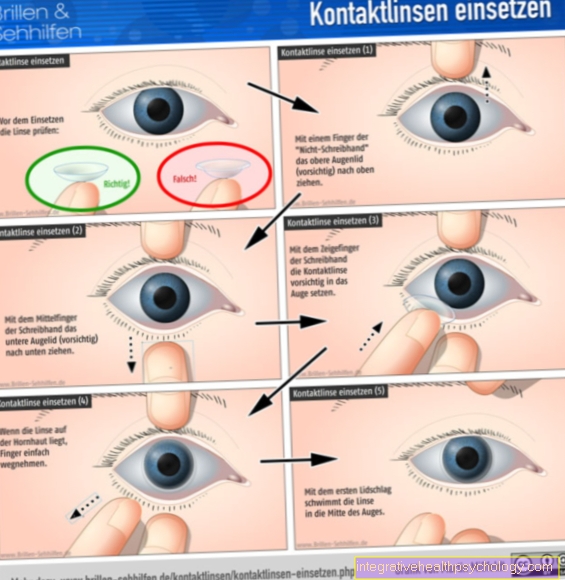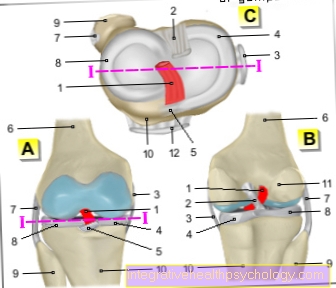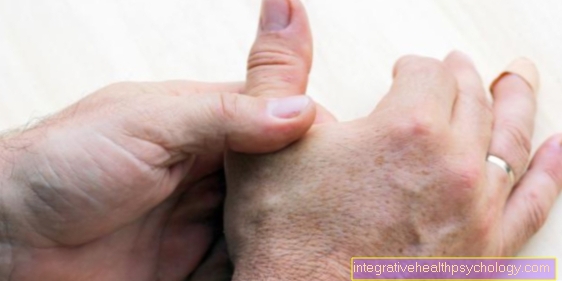Fear of loss in children
introduction
Fear of loss is a phenomenon that everyone has felt at different intensities. You can refer to many different things, such as the animals, objects, or the job.
In both children and adults, however, the most common target of fear of loss is the family. A certain fear of loss in relation to the family is present in all children, but this can be significantly increased by traumatic experiences for the child. Such events include a parent divorce, the loss of a close family member, or massive child neglect.
The resulting symptoms can be very diverse. Most of the time, the fear of being alone when going to bed and the dark, but also prolonged crying when one parent is only away for a few minutes, occurs.
If such excessive fears in children are not taken seriously and something is done about it, fear of loss in childhood can also affect behavior in later life. These include, for example, the difficulty of allowing closeness or entering into closer personal relationships.

causes
The underlying cause of excessive fear of loss in children usually lies in traumatic events that they have gone through in the course of their development. Events such as the loss of a sibling or a parent cause the children to cling to their caregivers even more so as not to lose them “too”.
However, other causes can also be the separation of the parents and the often associated loss of a caregiver, or significant neglect by one or both parents.
However, exactly the opposite, too strong a bond with a caregiver, usually the mother, can also trigger strong fears of loss.
All of these causes can prevent children from developing confidence that their parents will keep coming back after being gone for a short period of time. This leads children to perceive a separation, albeit a short-term one, as a loss, which can then express itself as a permanent fear.
You can find more information on the topic at: Attachment Disorders in Children.
diagnosis
The diagnosis of excessive fear of loss, referred to in psychology as the so-called "emotional disorder with separation anxiety of childhood", is made on the basis of certain observable behavioral patterns and the fears expressed by the child.
These include, for example, the refusal to go to school or kindergarten in order to be able to stay with the caregiver or persistent, but unrealistic fears of dangers that could separate the child from the caregiver. These fears may also affect the child as physical symptoms, which include headache, nausea and vomiting, or abdominal pain.
While most of these behaviors develop in most children, the most important factor in diagnosing such an emotional disorder is the extent and duration of the behavior.
What is normal and what is noticeable?
In principle, it is not possible to state an exact circumstance or a certain behavior, when fear of loss is still "normal" in children and from when they are considered "conspicuous", as these depend on many factors, such as the character of the child or the environment. In most cases, however, a comparison with children of the same age and an exchange with other parents about the behavior of their children helps in order to better assess one's own child.
It is completely normal and nature intended for babies and toddlers to start crying when they leave or when their parents lose their sight, because they have not yet learned that their parents keep coming back. This realization only develops over time, so that children at one year old do not always start crying as soon as the caregiver (mother or father) is not visible.
Read our article about this: Strangers in the baby.
Behavior would be described as “conspicuous” in which this process only occurs much later and children at the age of two or three years still show pronounced fear as soon as the caregiver moves away for a few minutes.
Another test for most children is the beginning of their kindergarten, as it is usually the first time that they are regularly separated from their parents for a longer period of time. Usually, however, children get used to the fact that they have to spend a few hours without their parents within a week or two. If this process takes significantly longer or if the fears that arise make even a visit to the kindergarten impossible, this can also be described as "conspicuous", whereupon one should deal specifically with the child's fears and find measures to cope with them.
Concomitant symptoms
In addition to the actual fear that occurs with this emotional disorder, other symptoms can also be associated with it. These include:
- Changes in behavior such as loud screaming and outbursts of anger in the face of an imminent short separation, for example on the drive to kindergarten,
- physical symptoms such as abdominal pain and headache, digestive discomfort up to nausea and vomiting,
- Bedwetting or
- a severe loss of appetite.
Read more on the subject below: Bed-wetting in children.
What are the consequences for the child?
The consequences of fear of loss in childhood for later life can vary extremely in their severity and depend largely on the point in time at which the fears were started to be alleviated.
Long-term studies have shown that people who suffered from severe fear of loss in their childhood or who still do so can have problems in social interaction with other people. These mainly consist in the difficulty of being able to form closer friendships or relationships.
In addition, it can be difficult for those affected to allow physical closeness.
There are also reports of the increased development of control compulsions or depression.
For these reasons it is important to take these fears seriously, if they exceed a certain level, and to try to alleviate them in order to prevent possible consequences for the later life of the child.
You can find general information on the subject of fear of loss and its consequences, as well as therapy options even in adulthood, at: Fear of loss
Therapy options
Basically, it's never too late to try to alleviate children's fear of loss.
- The focus here is above all on the relationship between child and parent, with the aim that the child can build trust in the relationship.
- There are various approaches to this, which can consist, for example, of creating rituals or playing times together.
- However, it is also important to try to find a direct conversation with the child and talk about the child's fears.
- In addition, an attempt should be made to create a comfortable and safe home for the child in order to create optimal framework conditions for this building of trust.
- Furthermore, the child's self-confidence should be strengthened, for example by praising certain behaviors.
However, it is also important not to draw the conclusion that you want to avoid every situation in which the child is afraid of loss. Initially, however, these should only be short enough for the child to be able to recognize the direct connection between the development of the fear and the return of the caregiver.This will teach them that the fear is unfounded as the mother or father will keep coming back.
Homeopathic therapy options
There are many different remedies that are used in the context of homeopathic therapy for separation anxiety.
Calcium carbonium is known, for example, as a remedy that is used in children who have particularly nocturnal separation fears about going to bed. However, it works Ignatia D12 Increasingly used in children who react to separation fears with physical symptoms (stomach pain, sweating, etc.).
Pulsatilla is used when children suffer from severe insecurity combined with fear of loss. In addition to the three most frequently mentioned homeopathic remedies, there are a number of other remedies that come from the group of Bach flowers and are used in connection with fear of loss.
Bach flowers
As part of the homeopathic treatment of a pronounced fear of loss in children, Bach flowers in particular are used in addition to the above-mentioned remedies. The most famous representatives of this group are
- the red chestnut,
- the spotted Gaucklerblume (Mimulus),
- the aspen (aspen) and
- the Oderming (Agrimony).
Which of these remedies is used in a particular case depends primarily on the quality of the fear and the triggering factors. The red chestnut is mainly used for fears that are associated with the fear that something might happen to the parents. The aspen, on the other hand, is used for a rather diffuse, indefinite fear.
Read more about this under: Bach flowers against fear in children.
When do fear of loss arise and how long do they last?
For fear of loss in children, it is not possible to give an exact age or a specific duration in which they occur and then disappear again. How long the fear of loss lasts differs from child to child and depends on many other factors, such as the trigger and how this fear is dealt with.
In most cases, however, the first year of kindergarten is affected, as this is the first time that the child is separated from their caregivers for several hours.
If parents recognize their child's fear of loss early on and try to alleviate it, these fears can usually be reduced significantly within a few months.





























